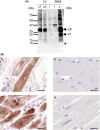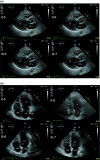Molecular autopsy and family screening in a young case of sudden cardiac death reveals an unusually severe case of FHL1 related hypertrophic cardiomyopathy
- PMID: 31293105
- PMCID: PMC6687666
- DOI: 10.1002/mgg3.841
Molecular autopsy and family screening in a young case of sudden cardiac death reveals an unusually severe case of FHL1 related hypertrophic cardiomyopathy
Abstract
Background: Hypertrophic cardiomyopathy (HCM) is a genetic cardiomyopathy with a prevalence of about 1:200. It is characterized by left ventricular hypertrophy, diastolic dysfunction and interstitial fibrosis; HCM might lead to sudden cardiac death (SCD) especially in the young. Due to low autopsy frequencies of sudden unexplained deaths (SUD) the true prevalence of SCD and especially of HCM among SUD remains unclear. Even in cases of proven SCD genetic testing is not a routine procedure precluding appropriate risk stratification and counseling of relatives.
Methods: Here we report a case of SCD in a 19-year-old investigated by combined forensic and molecular autopsy.
Results: During autopsy of the index-patient HCM was detected. As no other possible cause of death could be uncovered by forensic autopsy the event was classified as SCD. Molecular autopsy identified two (probably) pathogenic genetic variants in FHL1 and MYBPC3. The MYBPC3 variant had an incomplete penetrance. The FHL1 variant was a de novo mutation. We detected reduced FHL1 mRNA levels and no FHL1 protein in muscle samples suggesting nonsense-mediated mRNA decay and/or degradation of the truncated protein in the SCD victim revealing a plausible disease mechanism.
Conclusion: The identification of the genetic cause of the SCD contributed to the rational counseling of the relatives and risk assessment within the family. Furthermore our study revealed evidences for the pathomechanism of FHL1 mutations.
Keywords: cardiomyopathy; hypertrophic cardiomyopathy; molecular autopsy; nonsense-mediated decay; sudden cardiac death.
© 2019 Herz- & Diabeteszentrum NRW, Ruhr-Universitat Bochum. Molecular Genetics & Genomic Medicine published by Wiley Periodicals, Inc.
Conflict of interest statement
The authors have no conflict of interest.
Figures





Similar articles
-
Novel FHL1 mutation variant identified in a patient with nonobstructive hypertrophic cardiomyopathy and myopathy - a case report.BMC Med Genet. 2020 Sep 29;21(1):188. doi: 10.1186/s12881-020-01131-w. BMC Med Genet. 2020. PMID: 32993534 Free PMC article.
-
Evidence for FHL1 as a novel disease gene for isolated hypertrophic cardiomyopathy.Hum Mol Genet. 2012 Jul 15;21(14):3237-54. doi: 10.1093/hmg/dds157. Epub 2012 Apr 20. Hum Mol Genet. 2012. PMID: 22523091
-
Isolated X-linked hypertrophic cardiomyopathy caused by a novel mutation of the four-and-a-half LIM domain 1 gene.Circ Cardiovasc Genet. 2013 Dec;6(6):543-51. doi: 10.1161/CIRCGENETICS.113.000245. Epub 2013 Oct 10. Circ Cardiovasc Genet. 2013. PMID: 24114807
-
The pathology of hypertrophic cardiomyopathy.Histopathology. 2004 May;44(5):412-27. doi: 10.1111/j.1365-2559.2004.01835.x. Histopathology. 2004. PMID: 15139989 Review.
-
Genetic screening of patients with hypertrophic cardiomyopathy--a new diagnostic strategy for risk stratification?Bratisl Lek Listy. 2009;110(2):85-92. Bratisl Lek Listy. 2009. PMID: 19408839 Review.
Cited by
-
The Combined Human Genotype of Truncating TTN and RBM20 Mutations Is Associated with Severe and Early Onset of Dilated Cardiomyopathy.Genes (Basel). 2021 Jun 8;12(6):883. doi: 10.3390/genes12060883. Genes (Basel). 2021. PMID: 34201072 Free PMC article.
-
Compound Heterozygous FKTN Variants in a Patient with Dilated Cardiomyopathy Led to an Aberrant α-Dystroglycan Pattern.Int J Mol Sci. 2022 Jun 15;23(12):6685. doi: 10.3390/ijms23126685. Int J Mol Sci. 2022. PMID: 35743126 Free PMC article.
-
Postmortem Genetic Testing in Sudden Unexpected Death: A Narrative Review.Cureus. 2023 Jan 13;15(1):e33728. doi: 10.7759/cureus.33728. eCollection 2023 Jan. Cureus. 2023. PMID: 36643077 Free PMC article. Review.
-
Blood taken immediately after fatal resuscitation attempts yields higher quality DNA for genetic studies as compared to autopsy samples.Int J Legal Med. 2023 Sep;137(5):1569-1581. doi: 10.1007/s00414-023-02966-7. Epub 2023 Feb 11. Int J Legal Med. 2023. PMID: 36773088 Free PMC article.
-
New Insights on Molecular Autopsy in Sudden Death: A Systematic Review.Diagnostics (Basel). 2024 May 30;14(11):1151. doi: 10.3390/diagnostics14111151. Diagnostics (Basel). 2024. PMID: 38893676 Free PMC article. Review.
References
-
- Al‐Khatib, S. M. , Stevenson, W. G. , Ackerman, M. J. , Bryant, W. J. , Callans, D. J. , Curtis, A. B. , … Page, R. L. (2018). 2017 AHA/ACC/HRS guideline for management of patients with ventricular arrhythmias and the prevention of sudden cardiac death: A Report of the American College of Cardiology/American Heart Association Task Force on Clinical Practice Guidelines and the Heart Rhythm Society. Heart Rhythm: The Official Journal of the Heart Rhythm Society, 15(10), e73–e189. 10.1016/j.hrthm.2017.10.036 - DOI - PubMed
-
- Binder, J. S. , Weidemann, F. , Schoser, B. , Niemann, M. , Machann, W. , Beer, M. , … Windpassinger, C. (2012). Spongious Hypertrophic Cardiomyopathy in Patients With Mutations in the Four-and-a-Half LIM Domain 1 Gene. Circulation: Cardiovascular Genetics, 5(5), 490–502. - PubMed
-
- Christiansen, S. L. , Hertz, C. L. , Ferrero‐Miliani, L. , Dahl, M. , Weeke, P. E. , LuCamp, … Morling, N. (2016). Genetic investigation of 100 heart genes in sudden unexplained death victims in a forensic setting. European Journal of Human Genetics, 24(12), 1797–1802. 10.1038/ejhg.2016.118 - DOI - PMC - PubMed
Publication types
MeSH terms
Substances
LinkOut - more resources
Full Text Sources
Research Materials

